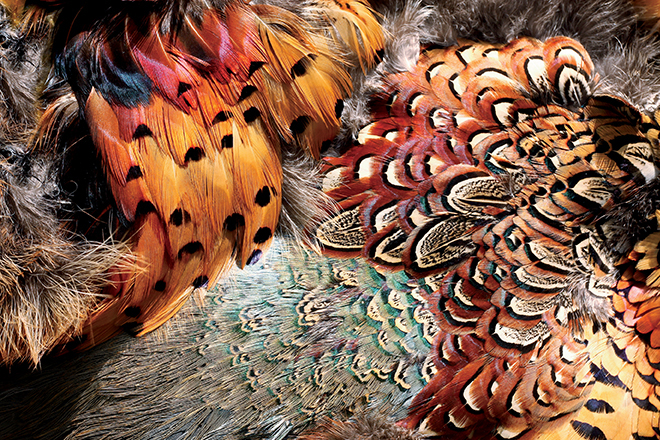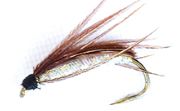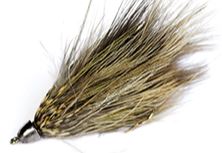12 FLIES YOU CAN TIE FROM ROOSTER FEATHERS
By Nick Simonson
Few other birds are held in such high esteem in fly fishing circles and among fly tiers as the rooster pheasant. From his iridescent blue-green head and white-ringed neck on down to the olive-gold rump feathers and grey marabou underneath, a single rooster can keep an outdoorsamn or woman occuipied for a long time at the fly vise.
OPTIONS BASIC TO ORNATE
Nymphs, dries, hoppers, streamers, simple, challenging, basic and ornate — all things are possible with rooster pheasant feathers. And in late season, feathers are mature and at their finest for both color and condition.
Even tailfeathers, barred in brown and black and trimmed in their iridescent lavender, make great flies that will catch everything from the wiliest wild rainbow trout to summer bluegills which attack with reckless abandon.
While those tailfeathers so commonly used in the bodies, tails and legs of various flies are the first ones thought of by hunters as well as tackle crafters, it’s the other feathers that truly make the bird shine in the wild and when it comes to crafting fly patterns at the vise.

Underbody plumes, soft and wispy in nature, can easily replace strung marabou in streamer patterns such as that found in the tail of the ubiquitous woolly bugger. Rump feathers and church windows on the back of the bird make marvelous soft hackling for collars that look great to fish in simple offerings like the Carey Special. The shimmering maroon almond hearts on the shoulders fold wonderfully into wings for caddisfly patterns, and the white and green feathers found up the neck and head can produce lifelike spent wings and parachutes on dry flies.
PERFECT PELT
Saving just one pheasant pelt can provide feathers for a lot of tying. The ideal pelt will be from an old, long-spurred bird; his feathers are the biggest and most well-developed of any in the game bag, but choose a bird not beat up by shot or dog.
GETTING STARTED
Fly fishing and fly tying are for everybody and anybody! Any fish that swims — and eats — can be caught on the fly, and likely on a pattern tied from pheasant feathers. The challenge of creating each pattern can be mastered with a bit of practice by even individuals with digital dexterity that registers on the “all thumbs” end of the scale!

Getting started in fly fishing itself requires only a basic 5-weight rod-and-reel combination (which often retails for under a hundred bucks) and can handle most anything from sunfish, crappies and trout on up to medium-sized pike and bass; and all those fish can be caught on pheasant feather patterns.
Tying one’s own flies is even less expensive. The basic tools required are a vise, scissors, bobbin and whip finisher. The entire kit shouldn’t cost more than $50 from any online retailer and often comes with secondary implements such as a hackle pliers and hair stacker for more advanced tying techniques.
The vise holds the hook, the scissors trim and cut materials to shape for placement, and the bobbin secures it all together with thread wraps before the whip finisher locks it all down with a final knot.
There are countless tutorials on the web in both print and video format to help new fly tiers up the learning curve, but finding a mentor or area fly tying club with members looking to share their wisdom helps even more.
Two-material flies, or even those with just one, such as the EZ Nymph following (which is constructed solely out of pheasant tail fibers) are the best way to understand how to adjust tension on a vise and bobbin, secure and manipulate materials on the hook shank, and get that little bit of extra practice needed to build thread heads and tie off the fly with a whip finish knot.
PATTERN OPTIONS
Start with larger-sized pheasant tail nymphs and wet flies and other simple streamer patterns such as the woolly bugger or a marabou leech, then work on smaller or more intricate patterns later. A dozen patterns with materials coming from a rooster pheasant follow. Experiment with each one and add personal flair and other alterations.
Pheasant feathers tie together the conservation practices which make great hunting and fishing possible. Make fly tying and fly fishing part of a full-circle upland experience celebrating the multi-colored rooster pheasant. Her are 12 patterns to get you tying ... and then catching!
12 PHEASANT FEATHER FLY PATTERNS
EZ NYMPH

HOOK: Nymph Size 10-16
THREAD: Black 6/0
BODY: Wrapped PT (Pheasant Tail) Fibers
WING: Folded PT Fibers
The EZ nymph starts with a selection of 8 pheasant tail fibers about 3 times as long as the hook shank and tied in at the bend of the hook. Advance the thread to behind the hook eye and wrap forward to form the body. Secure with a few thread wraps and fold them back to form the wing. Build a thread head, whip finish. It’s an easy first fly that catches fish.
KRYSTAL SHWAPF

HOOK: Nymph Size 10-16
THREAD: Black 6/0
BODY: Peacock Herl
SHELL: PT Fibers
WING: Folded PT Fibers
The Swept Hackle Wing All-Purpose Fly (or SHWAPF), designed by the late Black Hills fly angler Al Campbell, can be modified to match any insect. Tie in 8 pheasant tail fibers at the bend so they’re about twice the length of the hook shank, and then 3 strands of krystal flash. Advance the thread and wrap the flash forward for the underbody. Then tie the flash off and trim the excess. Fold the PT fibers forward to form the shell and secure with a couple thread wraps. Once locked in, fold them back to form the wing and make a thread head before tying off with a whip finisher.
PHEASANT TAIL NYMPH

HOOK: Nymph Size 10-16
THREAD: Black 6/0
TAIL, BODY, WINGCASE & LEGS: PT Fibers
RUBBING: Medium Copper Wire
THORAX: Peacock Herl
Designed to imitate a mayfly nymph, the Pheasant Tail Nymph does it all and is easily modified with color, beads, flash wingcases and more. It is the fly to have in a fly box and few anglers go without offering this pattern up over a given season.
TEENY LEECH

HOOK: 2X Long Nymph, Size 10-14
THREAD: Black 6/0
TAILS & BODY: PT Fibers
RIB: Medium Copper Wire
A pulsing mini-leech for trout and panfish, this pattern by Jim Teeny wiggles its three sets of tied-in PT fibers in an undulating fashion. Try using red or orange thread to form the head to make it a mini egg-sucking leech and to add some attractive color to the pattern when fish call for it.
CAREY SPECIAL

HOOK: 2X Long Nymph, Size 10-14
THREAD: Black 6/0
TAIL: Church Window Feather Fibers
BODY: Peacock Herl
COLLAR: 2 Turns of Church Window Feather
A small streamer designed to imitate a damselfly larva, the Carey Special can be worked for crappies and bluegills in still waters when these springtime insects are starting to emerge. Other materials like nymph dubbing or yarn can be substituted for the herl.
LIGHTNING BUG

HOOK: Curved Nymph, Size 10-14
THREAD: 6/0, Color to Match
TAIL: 6 PT Fibers
ABDOMEN: Wire Over Mylar Flash
THORAX: Ice Dubbing
Designed to imitate a mayfly nymph, the Pheasant Tail Nymph does it all and is easily modified with color, beads, flash wingcases and more. It is the fly to have in a fly box, and few anglers go without offering this pattern up over a given season.
PHEASANT ICE SOFT HACKLE

HOOK: 2X Long Nymph, Size 10-14
THREAD: Black 6/0
HEAD: Black Bead
TAIL: 8 PT Fibers
DUBBING: Peacock Ice Dub
COLLAR: 2 Turns of Church Window Feather
Back feathers make great collaring for soft-hackle flies and can be used throughout the body or just up behind the head. The shimmering edges give it an attractive iridescence in the water.
E’S PARACHUTE PT HATCHER

HOOK: Curved Dry, Size 10-14
TAILS & BODY: 8 PT Fibers
HACKLE: Brown Dry Neck Hackle
POST: Bunched White Neck Feathers
Designed to imitate a transitioning insect such as a mayfly in its most vulnerable state when stuck on the surface, this pattern designed by Norwegian fly guru Einar Bratteng combines the meatiness of a nymph with the surface draw of a dry fly. Grease up the hackle with some floatant and keep an eye on the white neck feather post as it drifts.
GARTSIDE CADDIS

HOOK: Dry Size 12-16
HACKLING: Brown Hackle,
Trimmed in Back, Left Full in Front
WING: Lacquered Pheasant Almond Heart Feather
With tightly wrapped hackle, this surface fly skitters like the real thing. Brush a bit of Sally Hansen’s Hard as Nails over the almond-heart feathers to ensure easy folding and durability, and color with a black sharpie and use darker hackle to imitate black caddis species.
PHEASANT RETORT HOPPER

HOOK: Curved Dry, Size 8-12
THREAD: Brown 6/0
BODY: Dry Fly Dubbing
WING: Shoulder Feather
LEGS: Knotted PT Fibers
HEAD: Spun Coastal Deer Hair
Most grasshopper patterns are slightly advanced, but the retort — a flashy pheasant answer to the turkey-based Letort Hopper — is the easiest of them all and incorporates two pheasant feather types for an awesome pattern for late summer trout and bluegills feeding on the abundant insects. Knotting PT fibers provides a challenge and the spun deer hair head takes some practice, but sure is fun to shape. Make sure the fly lands with a resounding “SPLAT!” on the water, just like the real thing.
CONEHEAD MARABOU STREAMER

HOOK: 3X Long Streamer, Size 2-6
THREAD: Black 3/0
TAIL & BODY: Pheasant Marabou
COLLAR: 2 Pheasant Rump Feathers
HEAD: Medium Conehead
Start the fly with the conehead in place by the eye, tie in a clump of dark pheasant marabou as the tail, and continue using clumps around the hook shank to create the body, stopping just short of the cone. There, tie in a pheasant rump feather and wrap it twice, trimming the excess. Repeat with a second rump feather and the collar is complete. Whip finish for an awesome fly that catches smallies, largemouth bass and even walleyes.
CAMDEN CRUNCH

HOOK: Collarless Jig 1/32 - 1/64 oz
TAIL: Short Pheasant Marabou
BODY: Medium Chenille
HACKLE: Trimmed Neck Hackle
COLLAR: 2 Turns of Church Window Feather
Named for a state park in southwestern Minnesota and its stretch of Redwood River loaded with eager browns, the Camden Crunch is a trout jig that pulls double-duty on the fly rod and light tackle. Keep the tails short to cut down on missed strikes and trim the hackle for that “crunchy” look. Works great on crappies too!
Nick Simonson is an outdoor journalist from Bismarck, North Dakota. He is a previous Pheasants Forever Volunteer of the Year (Minnesota) and hunts and fishes with his Lab Ole throughout the Upper Midwest.
This article originally appeared in the Winter Issue of Pheasants Forever Journal
.